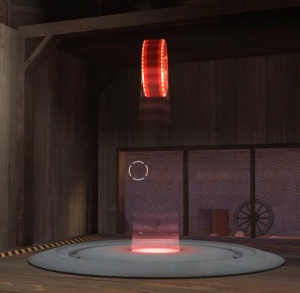trigger_capture_area
< Es
Jump to navigation
Jump to search
trigger_capture_area es una entidad sólida disponible en ![]() Team Fortress 2.
Team Fortress 2.
Descripción de la entidad
Rodea una zona con team_control_point para crear un punto de control. También se usa para definir una zona de empuje o bloqueo en una vagoneta de Carga Explosiva está definido func_tracktrain con su entidad asociada.
Valores clave
- Control point (area_cap_point) <targetname>
- Name of the control point this area is linked to.
- Can RED Cap? (team_cancap_2) <boolean>
- Can RED capture this point?
- Can BLU Cap? (team_cancap_3) <boolean>
- Can BLU capture this point?
- Number of RED players to start capping (team_startcap_2) <integer>
- Number of RED players needed to begin capturing this point. If not enough players are present, the point will say, "Waiting for teammate."
- Number of BLU players to start capping (team_startcap_3) <integer>
- Number of BLU players needed to begin capturing this point. If not enough players are present, the point will say, "Waiting for teammate."
- Number of RED players to cap (team_numcap_2) <integer>
- The maximum number of RED players to affect capture time.
- Number of BLU players to cap (team_numcap_3) <integer>
- The maximum number of BLU players to affect capture time.
- RED Spawn Adjust (team_spawn_2) <integer>
- Adjust the minimum respawn time for the RED team by this amount (in seconds) when RED captures this point. If the RED team owns this point when BLU captures it, this adjustment is reversed.
- BLU Spawn Adjust (team_spawn_3) <integer>
- Adjust the minimum respawn time for the BLU team by this amount (in seconds) when BLU captures this point. If the BLU team owns this point when RED captures it, this adjustment is reversed.
- Time to cap (sec) (area_time_to_cap) <integer>
- Time to capture this area (in seconds).
- Start Disabled (StartDisabled) <boolean>
- Stay dormant until activated (with the
Enableinput).
Inputs
- CaptureCurrentCP
- If a point is currently being capped, force it to cap fully.
- SetControlPoint <targetname>
- Set the associated control point to the name passed.
- SetTeamCanCap <string>
- Set whether a specific team is allowed to capture this point. Format is <team number> <0/1>; e.g., "2 0" would prevent RED from capturing this point, whereas "3 1" would allow BLU to cap it.
EnableDisable:
- Enable / Disable
- Enable/disable this entity from performing its task. It might also disappear from view.
Salidas
- OnStartCap
- OnStartTeam1
- OnStartTeam2
- Sent when either/RED/BLU team starts a capture.
- OnBreakCap
- OnBreakTeam1
- OnBreakTeam2
- Sent when a capture by either/RED/BLU team is broken.
 Nota:The capture progress on a point must be completely drained for the capture to be considered broken.
Nota:The capture progress on a point must be completely drained for the capture to be considered broken.
- OnEndCap
- OnCapTeam1
- OnCapTeam2
- Sent when either/RED/BLU team captures.
- OnNumCappersChanged <integer>
- Sent when the number of people in the capture area changes. The output value is the number of capturing players, regardless of if the capture is being blocked, and 0 if there are no capping players.
- OnNumCappersChanged2 <integer>
- Sent when the number of people in the capture area changes. The output value is the same as
OnNumCappersChanged, but is -1 when the capture is being blocked.
